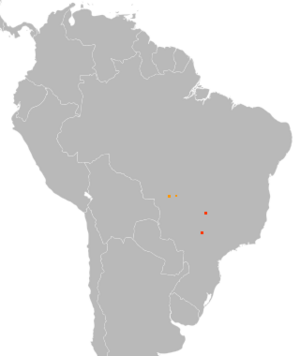Blue-eyed ground dove facts for kids
Quick facts for kids Blue-eyed ground dove |
|
|---|---|
 |
|
| Blue-eyed ground-dove | |
| Conservation status | |
| Scientific classification | |
| Genus: |
Columbina
|
| Species: |
cyanopis
|
 |
|
| Approximate ranges
Extant (resident) |
|
| Synonyms | |
|
|
The blue-eyed ground dove (Columbina cyanopis) is a small and rare bird. It is part of the Columbidae family, which includes doves and pigeons. This special bird lives only in the Cerrado region of Brazil.
Contents
About the Blue-Eyed Ground Dove
How Scientists Classify This Bird
Scientists group living things to understand them better. The blue-eyed ground dove was once in its own group, called Oxypelia. But later, scientists decided it fit better with other doves in the Columbina group. Even so, it has some unique features that make it stand out.
What Does It Look Like?
The blue-eyed ground dove is about 15.5 centimeters (6 inches) long.
- Males: Their head, neck, and chest are a pretty purplish-red. Their lower body and back are more brownish. The feathers under their tail are white. When their wings are closed, you can see dark brown and chestnut colors with shiny blue spots. Their tail feathers are reddish-brown in the middle and darker on the outside. They have bright blue eyes surrounded by bare gray skin.
- Females: They are usually lighter in color, especially on their undersides.
- Young Birds: Young doves have reddish edges on many feathers. The blue spots on their wings are not as clear.
Where It Lives and Its Home

The blue-eyed ground dove lives in open grasslands and savannas. These areas are part of Brazil's cerrado region.
For a long time, this bird was very hard to find. Since 1980, it has only been reliably seen in a few states in Brazil. These include Minas Gerais, Mato Grosso, and Mato Grosso do Sul. Since 2007, it has only been seen in Minas Gerais. There are also old records of it being seen in other states like São Paulo and Goiás.
In 2015, the blue-eyed ground dove was "rediscovered." This means people found it again after thinking it might be gone. By 2017, only about 27 of these birds were known to exist in the wild. In 2023, for the first time, chicks of this species were successfully raised by humans. This is a big step to help save them!
How It Behaves
What It Eats
Scientists don't have much information about what the blue-eyed ground dove eats. But like other doves in its group, it probably eats seeds.
Its Song
The blue-eyed ground dove has a soft, cooing song. It sounds like a series of even notes, often described as "wah," "wuh," or "prrah." You can listen to its song online.
Why It's in Danger
The IUCN (International Union for Conservation of Nature) has listed the blue-eyed ground dove as Critically Endangered. This means it is at a very high risk of becoming extinct.
Why is it so endangered?
- Very Rare: There are very few of these birds left.
- Habitat Loss: Its home, the cerrado, is quickly disappearing. This is mainly due to human activities like farming and development. Losing their habitat means these birds have fewer places to live and find food.
Scientists are working hard to protect this special bird and its home.


